The Complete TCPA Checklist for Business Texting in 2025
Use this TCPA checklist so your 10DLC registration can get approved and your texting campaigns can run smoothly without interruption.
10DLC registration is not just beneficial anymore, it's mandatory. Find out what it is, how to complete 10DLC registration, costs, deadlines, and more.
10DLC (10-digit long code) numbers for business text messaging were introduced a while ago, but only recently (early 2022) did major carriers make it mandatory for businesses to register those numbers.
On July 5, 2023, all mobile carriers started ramping up penalties for unregistered numbers, and on August 31 they began blocking texts from unregistered 10DLC numbers altogether.
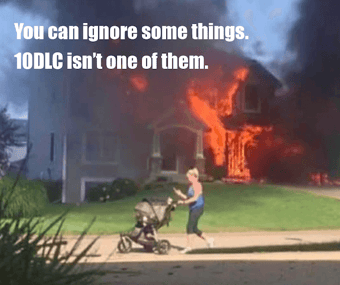
To ensure continued success with your text messaging campaigns (and maintain your reputation and ROI), it's important to get registered asap.
Registration itself is simple, but understanding what it all means and why you need it is... not. So in this post, we're going to cover everything you need to know.
The 10DLC situation has evolved pretty quickly since we first wrote this post, so here are some additional resources we've come out with since then:
10DLC stands for 10-digit long code, and 10DLC registration means that your number is registered through a third-party organization called The Campaign Registry (TCR). It's a process designed to ensure a positive and secure consumer experience and protect the performance of your text campaigns.
Upon registration, TCR verifies that your business is legitimate, then assigns each number in its registry a trust score which carriers then use to prioritize text message delivery. In other words, the higher your trust score, the higher your delivery rates and throughput.
To apply for 10DLC registration, you need to provide your Campaign Service Provider (CSP) with the required information (which we'll get to later), and the CSP will submit your application. Businesses don't interface directly with TCR. There is a one-time registration fee as well as a monthly campaign fee.
To get your registration approved, your business information all needs to be verified and you must adhere to industry best practices as outlined by the Telephone Consumer Protection Act (TCPA). These include but are not limited to:
While you'll see July 5 below, the registration process, which normally takes about a week, is currently taking 2-4 weeks due to the influx. So it's important to get your registration application submitted now to avoid disruptions in your campaigns.
On July 5: All major carriers (AT&T, Verizon, etc.) will start throttling (reducing deliverability throughput rates for messages from unregistered 10DLC numbers.
On August 31: Carriers will block texts from unregistered numbers altogether.
10DLC registration costs vary depending on the type of business you have and the campaigns you’re running. You’ll pay:
Not sure which type of "Brand" you are or which campaign you'll be running? These links are helpful:
NOTES ON COSTS:
The registration process for 10DLC is pretty simple, but there are some terms you need to know:
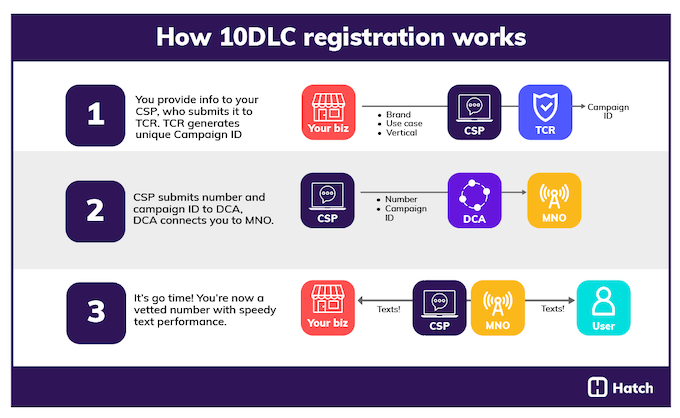
Your business itself doesn’t directly apply for registration through TCR. You provide your information to your CSP and your CSP registers you.
TCR registration application requires the following information, but the form your CSP uses to collect the information from you may be different, since they may take care of some of it for you.
Here’s what TCR registration asks for:
Hatch customers, the information you need to provide via our form is:
We'll take care of everything else.
Your CSP will then submit the information to TCR, which will then assign each registered number a unique campaign ID.
Your CSP then provides the DCA with those numbers and their Campaign IDs, and they will enter them into a shared industry database which allows that number to go live. Now the messages sent out from that number can be properly routed to and from customers by the MNOs.
You’re live! You can now message end users as an approved, trustworthy, fully vetted sender and enjoy the benefits of higher deliverability, faster throughput, lower traffic fees, and higher ROI.
Hatch customers, as a CSP, we will register your 10DLC number. Fill out the form we share with you in the app and we'll take care of the rest—that includes all the backend work and communicating with our contacts at each cellular service provider to ensure you're compliant and ready to go.
Non-Hatch customers, reach out to your campaign service provider to see what action is required.
Here are the terms and history that will give you additional context for wrapping your mind around 10DLC.
A2P-10DLC is when a business uses an application or software to text consumers (A2P) from a secure, vetted 10-digit phone number (10DLC).
To understand what that means and why it's important, there's some unpacking we need to do.
A2P stands for application-to-person messaging, and it refers to when businesses use an application or software to text consumers so they can do so in large volume. It’s basically the technical term for business texting, integrated texting, or SMS (short message service).
So if you use Hatch, you’re using A2P messaging.
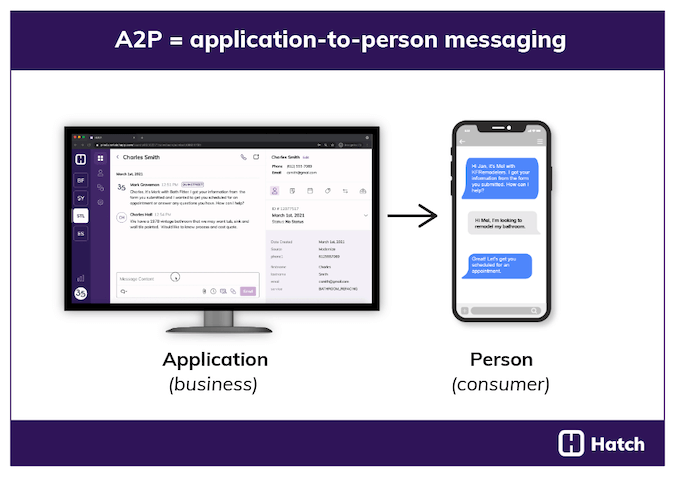
Businesses then send their A2P messages from a phone number, which can be:
What are the differences between these numbers? So glad you asked!
Each of these number types vary in their appearance, throughput (speed, in messages per second), security, and deliverability. Note that short code, shared short code, and toll-free numbers already had their own mandatory registration processes established).
This is when businesses use a five or six digit number for A2P messaging. These numbers are easy to remember, and they have high throughput (speed, in messages sent per second), so they’re best suited for high-volume text campaigns where immediate delivery is critical. SMS short code supports multimedia messaging (MMS) and delivery receipts, but not voice services.
These numbers have 800 instead of an area code. They incur no fees, but the 800 number can be off-putting to consumers and they are often subject to messaging caps and spam filters.
This is when a business uses a standard 10-digit phone number with a local area code. This type of number supports MMS and voice services, but not delivery receipts.
Long code numbers have lower throughput than short codes, but they have lower costs and tend to get more engagement as the local phone number feels more personable and trustworthy. 10DLC code numbers are a great, cost-effective solution for small businesses.
When business text messaging first came out, there were very few regulations and consumers were getting bombarded.
In response to this, from 2017-2020 the Cellular Telecommunications and Internet Association (CTIA), major mobile carriers (like Verizon, T-Mobile, and AT&T) and other institutions began rolling out regulations and programs to make texting secure and successful for consumers and businesses.
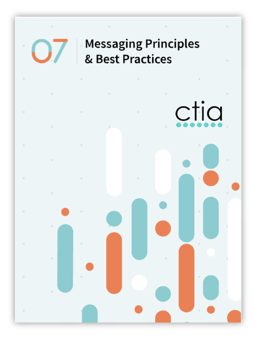
CTIA’s Messaging Principles and Best Practices
Then in March of 2022, major mobile carriers AT&T, T-Mobile, and Verizon came out with a united policy that any business using 10-digit long code numbers (10DLC) for text messaging campaigns must register them through a national registry called The Campaign Registry (TCR); and that unregistered numbers would be subject to higher fees, slower and lower delivery rates, and sometimes blocked delivery altogether.
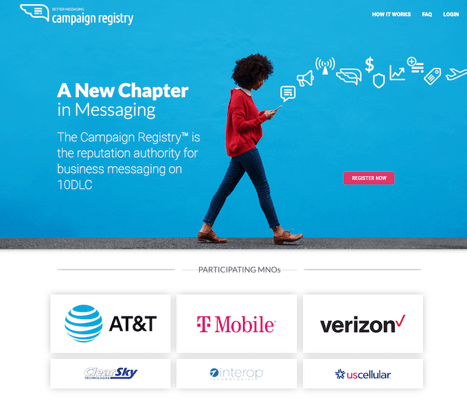
Since then, carriers have been periodically ramping up these consequences to ensure a secure experience for consumers.
But this summer, we’re going to see more penalties starting July 5, 2023—and eventually complete blockage starting August 31, 2023—for unregistered 10DLC numbers.
As you can now see, it's not just SMS that is beneficial to your business, but SMS via 10DLC—and for a number of reasons:
10DLC numbers are each assigned a reputation score by TCR, which mobile carriers then use to prioritize messages. The higher your reputation score, the better your deliverability. On the flip side, unregistered numbers are subject to spam filters, slower sends, and sometimes even blocked traffic.
Throughput represents messages per second (MPS). Higher throughput means more messages can be sent at once and on time.
Your throughput will vary depending on your trust score, but 10DLC numbers have higher throughput than traditional long code numbers.
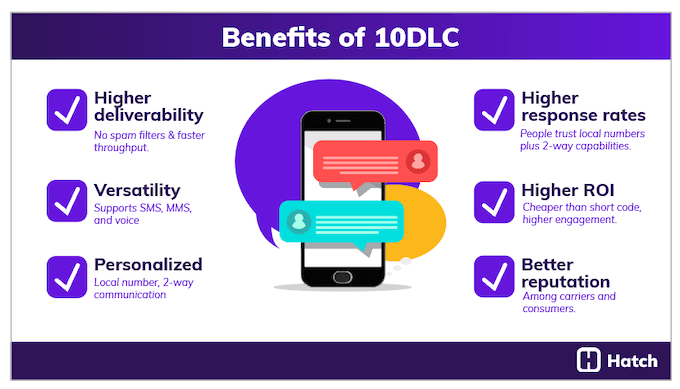
Local numbers feel more trustworthy and familiar to consumers. Plus, 10DLC supports two-way text messaging and multiple media types. These all factor into higher response and engagement rates from consumers.
While short codes can only be used for texting, long code numbers support text, MMS, and voice so you can use one number for a wide range of messaging strategies—appointment reminders, marketing campaigns, customer service, and more. This makes it a versatile and scalable solution.
With more of your text messages to leads, prospects, and customers getting delivered and higher response rates, you’re then able to hit your marketing and business goals, resulting in higher returns on your A2P and text marketing investments.
Businesses that use A2P 10DLC texting aren’t actually the ones who do the registration. The app you use for messaging (the A in the A2P, aka your campaign service provider, or CSP) does the registration for you.
Hatch is a CSP, so we'll take care of registration and all of that is found in the app. If you're not a Hatch customer, reach out to your CSP to find out what the process is.
10DLC registration costs vary depending on the type of business you have and the campaigns you’re running. You’ll pay:
NOTES ON COSTS:
10DLC registration typically only takes a few days, but right now due to high demand, it’s taking 2-4 weeks.
If you don’t need a localized area code, a toll-free number can be an alternative. Both toll-free and short code numbers have their own mandatory registration and verification processes, and with the influx of 10DLC registrations happening, the waiting period could be shorter for toll-free numbers.
Delivery rates and throughput from toll-free numbers are not too different from standard low-volume 10DLC numbers. However, keep in mind that toll-free numbers are subject to spam filters.
There is no official deadline for registering your 10DLC number, but the consequences for unregistered numbers (higher fees, reduced performance, poorer reputation, lower ROI) will continue to get more severe, so the sooner you register, the better.
Businesses that don’t register their 10DLC numbers will continue to see higher fees, lower deliverability, slower throughput, and sometimes blocked traffic altogether—not to mention a poor reputation among mobile carriers and consumers. All of this will have a negative impact on your text campaign performance and ultimately your ROI. So it’s important to get registered ASAP!
TCR requires information that declares who you are and what types of text messages you’ll be sending.
TCR registration application requires the following information, but since your CSP is the one who registers you, the form you have to fill out for your CSP may have fewer fields, since they may take care of some of it for you.
Hatch customers, the information you need to provide via our form is:
We'll take care of everything else.
Back when business text messaging first took off, it sort of turned into the wild west. There were no regulations and consumers were getting spammed, scammed, and/or bombarded with texts. In response to this, cellular service providers, TCIA, and other institutions began implementing regulations to make texting work for consumers and businesses.
This is all meant to make your text messaging campaigns fruitful for your business as well as secure and pleasant for consumers.
Sure are!
And if you need help identifying which type of brand you are or campaigns you're running:
Use this TCPA checklist so your 10DLC registration can get approved and your texting campaigns can run smoothly without interruption.
Discover how Hatch’s delivery status feature helps you gain more visibility into your communication data and ensure compliance with 10DLC regulations.
The 10DLC compliance situation is a hot mess. We're untangling it so you can ensure your business text messages are getting delivered.
Be the first to know about new sales and marketing insights to grow your messaging strategy with leads and customers.